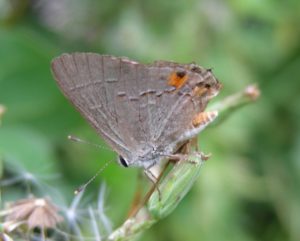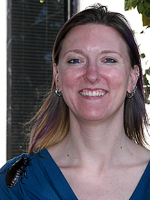Gossamer winged butterflies, family Lycaenidae, are the second largest family of butterflies after Nymphalidae. There are over 6,000 species in the world with over 100 species in North America.
Characteristics of Gossamer Winged Butterflies
Adults are small, usually under 5 cm, brightly colored, and often metallic. Many species will have tails on the hindwing. The larvae are flattened and slug-like and have a gland that releases a sugary substance similar to honeydew that is used to “bribe” ants for protection. Lycaenindae is split into 7 subfamiles, 3 of which are not found within the U.S.- Aphnaeinae, Portiinae, and Curetinae.
Lycaeinae Family – the Coppers
Family Lycaeinae, the coppers, are found in northern and western U.S., are small in size with a brilliant coppery orange on the upper surface of their wings. These butterflies aren’t seen too much within the state, but can be found in more northern regions.
Theclinae Family – the Hairstreaks

Male hairstreak butterflies will defend territory around their perch areas.
The hairstreaks, family Theclinae, are common throughout the state. They get their name from the “hairlike” lines crossing on under surface of the wings. Most hairstreaks have slender tails on their hindwings. The tails on the hindwing have eyespots, making it look like a false head to help the butterfly evade predators. Tropical species sport bright colors, unlike Texas butterflies which are mostly gray or brown. The patterns of lines and spots on the underside of the wings are used for identification. Hairstreaks are fast flying and tend to dart around erratically. Males will defend territory around their perch areas.
Miletinae Family – the Harvesters
Family Miletinae, the harvesters, has one species, Feniseca tarquinius, found in North America and Texas. The butterfly is orange with brownish-black borders and spots on the upperside of the wings. The underside of the wings are pale orangish-brown with dark brown spots with whitish rings. This butterfly’s caterpillar is carnivorous, feeding on wooly aphids. Adults eat honeydew from aphids as well as fluids from tree sap, carrion, and dung.
Polyommatinae Family – the Blues
The blues, family Polyommatinae, get their name from the blue upperwings of many of the males. Females are more brownish with wide, dark borders and blue towards the body. You can confirm the species identify by the pattern of spots on the underwings. Blues flight is more fluttery, but they are able to dart away when needed. Males often gather at mud puddles and wet sand to get moisture, salts, and amino acids.
For more information or help with identification, contact Wizzie Brown, Texas AgriLife Extension Service Program Specialist at 512.854.9600.
About Wizzie

Wizzie Brown
County Extension Program Specialist – Integrated Pest Management
Email:EBrown@ag.tamu.edu
Wizzie has been with Texas A&M AgriLife Extension Service since 2002 and has been playing with insects since she was a toddler. She is an Extension Program Specialist with the Integrated Pest Management (IPM) program. Wizzie holds a B.S. in entomology from The Ohio State University and a M.S. in entomology from Texas A&M University. The integrated pest management program provides identification, biological and management information to whomever needs help. Wizzie’s research focuses on imported fire ants, including community wide fire ant management. Wizzie also is happy to provide programs to area groups on a variety of arthropod-related topics. You can find insect and other arthropod information on Wizzie’s blog.
